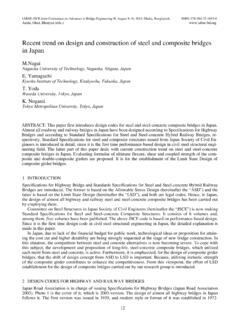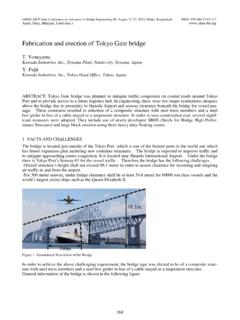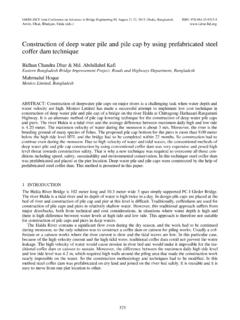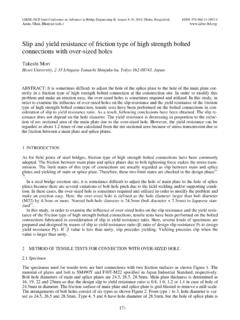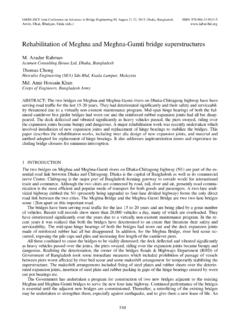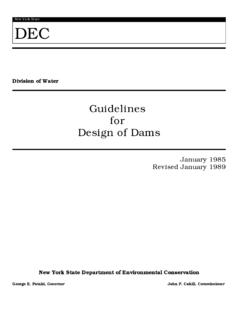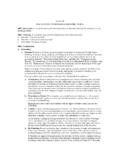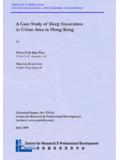Transcription of Geotechnical problems of bridge construction in Bangladesh
1 Japan- Bangladesh Joint Seminar on Advances in bridge Engineering ISBN: 984-32-2520-6. Dhaka, Bangladesh . 10 August 2005. Geotechnical problems of bridge construction in Bangladesh Safiullah*. Department of Civil Engineering Bangladesh University of Engineering and Technology,Dhaka 1000, Bangladesh . Abstract The paper deals with various foundations used in Bangladesh for river crossing bridge structures. Some of the problems of construction and design of these foundations are highlighted. Because of the fact that most alluvial deposits of Bangladesh contain significant percentage mica, their effect need to be assessed in the interpretation of foundation design and slope stability calculations. The existing correlations using SPT values should be verified for these soils and there is a need for research in this area. For three large bridges in Bangladesh Osterberg (O-cell). cell tests have been performed. It has been observed that use of base grouting and skin grouting can significantly increase pile load carrying capacity.
2 1. Introduction Bangladesh is a low-lying country crisscrossed by numerous rivers. Communication network has been a great challenge for road and rail-line construction , as most road or rail-line links require building of numerous river crossings. Three large rivers: the Padma, the Jamuna and the Meghna divide the country. Most of these rivers have braided characteristics that make the banks unstable and variable soil condition exist across the crossings. Geotechnical conditions for foundation construction for bridges has been challenging for many reasons. Distribution of soils across crossings is complex and are usually heterogeneous both in vertical and horizontal direction. Soils consist of wide varieties of material ranging from poorly graded sand to silt and clay. In general there is a predominance of silt-sized materials and most often sandy soils contain significant percentage of mica. The presence of mica itself provides some unique characteristics to these soils that have been little studied in Geotechnical literature.
3 Most of the older bridges built in this country are founded on well or caisson foundations. Because these well foundations were open caissons, it did not require any *. E-mail: 135. heavy or specialized equipment to construct them except for equipment for grubbing soil from within the well. But there have been frequent problems of undesirable sinking or difficulty in sinking of these caissons that delayed the construction time. Some case studies of such problems are described in this paper. With the development of bored pile construction in this country, the current tendency is to build bridge piers founded on large diameter bored piles. Driven piles are seldom used for bridges in Bangladesh except for very small brides where scouring is not significant and driving is not a problem. The only major bridge built in Bangladesh that is founded on large diameter tubular steel piles is the Jamuna bridge . Foundation for this bridge lies on m and diameter battered piles of about 80m long driven in medium dense granular micaceous sand.
4 Obviously such driving required very heavy driving equipment that very few contractors own globally. This paper reviews some bridge foundation design and construction practice followed in Bangladesh and reflects some case studies of the type of Geotechnical problems that needs to be overcome to develop towards advancement of bridge construction in Bangladesh . 2. Caisson foundations Caisson foundation have been very popular in Bangladesh for a long time because of the ease with which these could be built without use of any heavy or sophisticated machinery or equipment. Some of the large bridges have been founded on this type of foundation. Before starting construction of a caisson within riverbed, the local practice is to build a sand island. Since the sand islands are temporary structures these are usually built of sheet pile enclosure filled with sand. In deep waters where scour is a problem often stability of the sand island requires critical examination.
5 In shallow waters, sometimes wooden piles (shal-bolli) are driven closely with some bamboo mattress inside that retains sand for Sand Island. There have been instances where Sand Island has been washed out, tilted or displaced the caisson built inside it, which, necessitated either change in alignment or readjustment of the bridge spans. Often there are considerable problems with sinking of caissons by overcoming skin-friction. Sinking in conditions where skin friction is considerable lateral jetting becomes essential along with use of drilling fluid (usually bentonite). This requires thoughtful arrangement of internal piping and mud circulation, which is seldom followed by our contractors resulting in delay in construction , uneven sinking and even collapse of caisson. Problem with construction of 2nd Buriganga bridge The 2nd Buriganga bridge over river Buriganga connects heart of Dhaka city at Nayabazar with Jinjira on the other side. The total length of the bridge within the limit of contract is 1479 m while the span within the river portion is 304 m and founded on five caisson foundations.
6 The depth of these caisson foundations varied between m and m. Each caisson is oval shaped with external dimensions of 6 m by m. The construction of the bridge commenced on 29th August 1994. During middle of September 1996, difficulties developed during construction of the caisson foundation for pier no. 17. After the caisson was sunk to a depth of about 16 m. there was difficulty in further sinking although grubbing and soil removal from inside of the caisson was in progress. Some 4 to of soil were removed from inside the 136. caisson but the caisson did not sink by its own weight. There were no inbuilt outer jetting arrangements within the caisson walls. At this stage the contractor used a GI pipe 18 m long to inject water close to the caisson wall and this jetting continued at one-foot interval. When half the diameter of the caisson was covered, water suddenly oozed out from the caisson and the caisson sank to a depth of m and the level of soil inside the caisson raised to a depth of about 7 m above excavated ground inside the well.
7 The top of the caisson went under river water level. Fig. 1 shows the condition of the caisson before and after sinking. It can be seen from the figure that before sinking the caisson had a grip length of about 16 m (52 feet). Fortunately because of this grip length there was no tilting of the caisson and the sinking could be continued to desired depth despite the fact that top of the caisson went below river water level. Two important lessons were learnt from Buriganga. Adequate internal jetting arrangements should be provided for caissons where significant skin friction is likely to develop. If external jetting is to be used it should be done symmetrically so that uniform sinking takes place. One need not go for excessive removal of soil from within the open caisson without releasing skin frictional resistance in uniform manner. El WL El El GL El GL El El Tip El Soil El Tip El. Position after Position sinking before sinking Fig. 1. Position of caisson on Pier 17 of the Buriganga bridge before and after sudden sinking on September 1996.
8 Failure of caisson on Kalidash-Pahalia Khal bridge on Feni-by-pass It may be recalled that in 1976 during installation of a caisson for the bridge on Kalidash Pahalia Khal on Feni-by-pass road, due to heavy inrush of water of the flashy river the 137. caisson tilted and failed. The reason for failure was investigated and found to be due to inadequate depth of embedment and resulting scour at the time of high river flow (Hossain et al, 19831). Therefore due importance should be given to the grip length of the caisson at the time of construction . 3. Bored pile foundation Although this type of foundation induces more turbulence and scour at the riverbed level it is becoming popular due to development of technical capability to built very large diameter piles, faster construction and better construction techniques and also due to elimination of the need to construct sand island. Large diameter bored piles are gradually replacing caisson foundation in bridge construction in Bangladesh .
9 The Japan- Bangladesh Friendship bridge over river Meghna is built on piers founded on bored piles. The construction of foundation at riverbed level required construction of a watertight cofferdam built with steel pipe piles (diameter: m, length: m) with vertical interlocking system. The cofferdam had to be braced with heavy steel pipes to resist external water pressure when inside is drained out. After installation of bored piles within the cofferdam, the inside had to be dewatered for excavation and preparation of bed for pile cap and pier. Fig. 2 shows pile head treatment for construction of pier within the cofferdam. Cast-in-situ concrete piles of in diameter were constructed by using reverse circulation drilling method. Special measuring system was adopted for the vertical accuracy of the boreholes. The lengths of these piles are variable ranging from m to m depending on the level of the bearing strata for the piles. Fig. 2. Pile head treatment for construction pier foundation inside the cofferdam.
10 (Courtesy: Roads and Highway Department, Bangladesh ). Most of the bored pile foundations used for smaller bridges use Sand Island instead of the type of cofferdam used for the Meghna bridge . Because the pile tops are placed at the surface of the sand island, which is above river water level, bottom of pile caps are above riverbed, creating turbulence and excessive scour at riverbed level. Some times 1. Hossain, ; Salahuddin, M and Hasan, A (1983): A case study on Kalidas Khal bridge caisson failure. Unpublished undergraduate thesis, Department of Civil Engineering, BUET. 138. piles develop defect due to bad construction practice that relates to borehole formation, borehole cleaning and underwater or tremie concreting. Fig. 3 shows an example of bad concreting that developed within the piles just below pile cap for one of the pier of Dhaleshwari-1 bridge . From the photograph it can be observed that there is discontinuity in the top casing where the concreting was affected.
